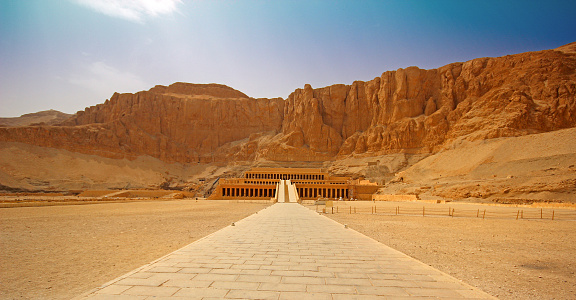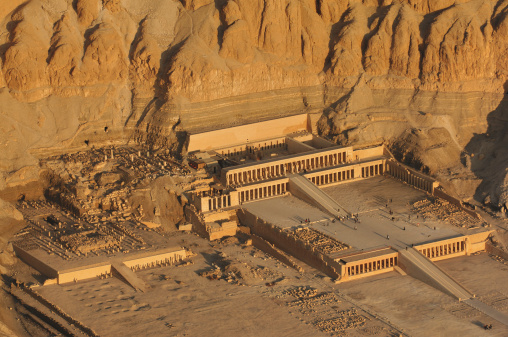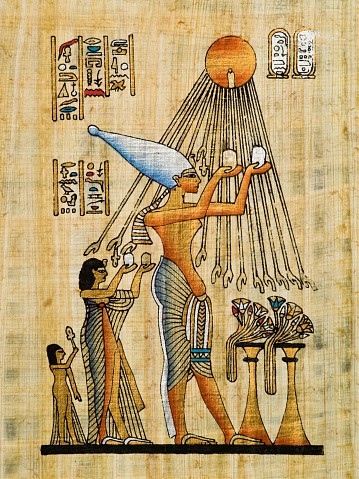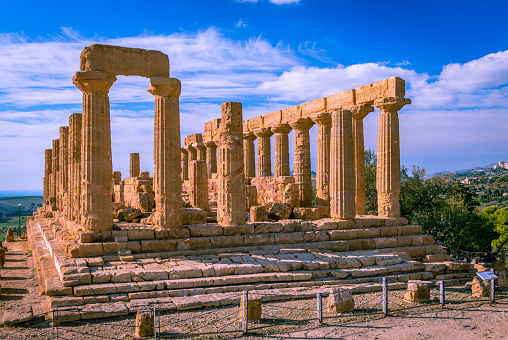The Short Answer
The short answer is no. We have discovered over a hundred pyramids in Egypt, but they were not all for pharaohs. Some of them housed the children of pharaohs, such as the minor pyramids around the Pyramids of Giza that hold Khufu’s other children inside.
However, there were way more Pharaohs over the thousands of years of history of Ancient Egypt and the three different Kingdom periods that Egypt went through than there are pyramids in Egypt. So, if they weren’t buried in pyramids, what were the rest of the kings buried in?
Old & Middle Kingdom
Before the Pharaoh Djoser who was buried in the Great Step Pyramid of Djoser, Pharaohs were not buried in any kind of pyramid. Instead of pyramids, they were buried in tombs called mastabas.
Mastabas are a bit more elaborate than normal tombs, but they are definitely nowhere near as imposing as Step Pyramids or True Pyramids. This was the burial method for virtually every Pharaoh from the first few Dynasties of Egypt’s rule.
After the Pyramids of Giza, Pharaohs did not build any pyramids that were nearly as massive in size as those. Likely, they were too expensive.
So instead of being buried in pyramids, most of these Pharaohs returned to rather traditional tombs. At some point in the Middle Kingdom, pyramids briefly returned but they were made out of mud bricks instead of limestone which caused them to fail to last until the modern times.
However we can see where they once were because of the unnatural structures in the ground. This is how archaeologists and historians usually discover things–they go out to places where history says things happened and look for movements of the earth that aren’t natural.
New Kingdom
In the New Kingdom of Egypt, they constructed a tomb for all of the pharaohs and other noblemen called the Valley of Kings. The Valley of the Kings is host to a whole several centuries of Egyptian leadership’s final resting places.
The Valley of the Kings is located near the Nile River. It is actually on the opposite side of where the ancient city of Thebes is located.
Originally, pharaohs’ wives were also buried with them in the Valley of the Kings and sometimes their children were buried with them as well. However, this practice ended once a separate Valley was excavated for the queens which became the Valley of the Queens.
The Valley of the Queens is also located near both the Valley of the Kings and the city of Thebes.
Did The Pharaohs Without Pyramids Leave Anything Behind?
Well, actually, yes! Many of the Pharaohs from the New Kingdom did in fact leave behind structures for other people to see as monuments of their leadership.


The temple of Hatshepsut was built by Hatshepsut during her reign in the New Kingdom period as a renewal of monument building. The temple served as a site for worship of primarily Ra but also other Egyptian deities as well.
The temple was most likely completed around the seventh year of Hatshepsut’s rule. She oversaw the construction of it herself.
Quite a lot of architectural genius went into the construction of this temple. Most obviously is the fact that they were able to make the top look as if it was directly on top of the bottom when you approach it.
However, Hatshepsut’s temple was not well taken care of after her rule. For unknown reasons, Pharaoh Thutmose III had all of Hatshepsut’s legacy (including references to her in her own temple) erased.
Why he did this, we are not sure. The general belief is that Egyptian society had just grown to resent the fact that it had a female Pharaoh, which was definitely an oddity, but I’m not sure personally. He waited a whole twenty years after she was dead to do it.
Later, the temple was damaged once again. This time the culprit was the pharaoh Akhenaten.

Akhenaten broke away from the orthodox beliefs of the Egyptian religion. He turned away from Egypt’s traditional gods.
In place of Egypt’s traditional gods, Akhenaten proposed the god Aton. Aton is a Sun God, and Akhenaten proposed that he was the supreme being and that he was the only deity worth following.
Going along with this mentality, Akhenaten destroyed a lot of images of the old Egyptian gods. Included in this, Akhenaten went into Hatshepsut’s temple and had all the images of other Egyptian deities destroyed–especially ones of Ra.
Akhenaten died with a rather lofty hatred built up for him by the clergy of ancient Egypt. And so, with the next Pharaoh, Tutankhamun, they reinstated the traditional religion and got to work on restoring the old imagery.
During the reigns of Tutankhamun, Horemheb, and Ramesses II, Hatshepsut’s temple was restored as best as possible. Then the temple was damaged again by an earthquake that occurred at some point between 1,000 BC and 600 BC (the Intermediate Period after the New Kingdom ended).
During Ptolemaic Egypt (305 BC to 30 BC), the temple was restored along with many other things. The Ptolemys also built additional structures onto the temple as well to renovate it more with their modern times.
However, the temple would once again come under attack. This time, it was the Coptic Christians from about 500 AD to about 700 AD.
The Coptics turned the temple away from being a pagan temple to the Egyptian deities and then renovated it so that it would instead function as a Coptic monastery. These renovations included painting over everything to replace it with Christian imagery.
In addition, graffiti has been variously put onto the temple over the centuries. Some of the graffiti has been identified as coming from the 1200s.
Today, Hatshepsut’s temple has been re-excavated from the rocks and is currently under projects for restoration by the combined efforts of various groups.

Another famous Egyptian temple that was built as a monument by a New Kingdom pharaoh is the Luxor Temple. The Luxor Temple was built by Pharaoh Ramesses II and is not actually dedicated to any specific deity–you can worship whoever you wish to there.
The Luxor Temple, along with the rest of Luxor, was a very popular place to visit for many peoples of the Ancient world including Babylonians, Greeks, Phoenicians, and others. Alexander the Great was claimed to have been crowned inside of the Luxor Temple.
Ramesses II was a very popular pharaoh for the Egyptians. He was so popular that some even refer to him as being Ramesses the Great.
Ramesses II is also believed to be the pharaoh who is depicted in the Biblical story of Moses, as this would be what lines up best with when those events probably took place year-wise. It’s hard to tell because the Egyptians had a habit of erasing records that they did not like, and a rebellion would most likely be one of those qualifying events for erasure.
Egyptian Architecture Goes Abroad

See the structure of those columns? Rather wide and jutting out a bit.
Now compare those columns to the columns at the Luxor Temple. Rather similar aren’t they? They are and there is a reason for this.
The Greeks were frequent trading partners with the Egyptians, they both exchanged ideas openly with one another. And, as can be seen in early Greek art and architecture, Greek art and architecture started out as an adoption of the styles of Egypt.
However, the Greeks would begin evolving into their own style as they moved towards the Classical Age.